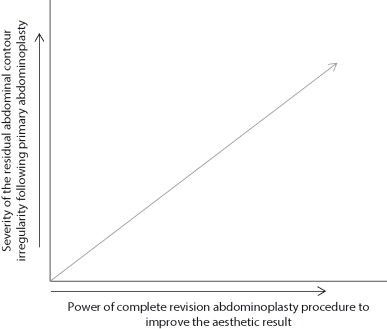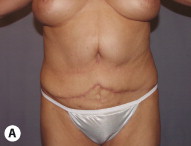IN THIS CHAPTER
- •
Introduction 131
- •
Patient selection 132
- •
Preoperative history and considerations 132
- •
Operative approach 133
- •
Postoperative Care 137
The goal of complete revision abdominoplasty is to improve and optimize the aesthetic appearance of the abdomen following a prior abdominoplasty. It involves full elevation of the abdominal soft-tissue apron, which allows any residual myofascial laxity and soft-tissue excess to be properly addressed. Depending on the needs of the individual patient, complete revision abdominoplasty may include some or all of the normal components of a standard abdominoplasty, including concurrent liposuction of the abdomen, strong myofascial plication, and additional skin and soft-tissue resection. Improvement in the quality and position of the scar, the shape and position of the umbilicus, and correction of any sequelae from the previous procedure are also addressed. The type of procedure performed during complete revision abdominoplasty may differ from that originally performed and should be selected according to the patient’s needs and wishes. A detailed examination and discussion is critical for an optimal aesthetic result and high patient satisfaction.
Introduction ( Box 11.1 )
Complete revision abdominoplasty is the term used to describe a revision abdo-minoplasty procedure that involves complete dissection and elevation of the abdominal soft-tissue apron. In so doing, residual myofascial laxity can be corrected and residual soft-tissue excess can be resected. This procedure is performed to correct and optimize the aesthetic result of a previous abdominoplasty or abdominal contouring procedure.
The abdominoplasty technique was not properly selected or performed, leading to:
- •
Insufficient correction during the prior abdominoplasty procedure
- •
Insufficient or no myofascial plication
- •
Insufficient or no concurrent liposuction
- •
Insufficient soft-tissue resection
- •
Poorly designed/executed procedure leading to
- •
Poor scars: asymmetry, position, quality
- •
Unattractive umbilicus
- •
Lateral dog-ears
- •
Complete revision abdominoplasty may also includes scar revision and scar repositioning, improvement in umbilical shape and location, as well as liposuction of the abdomen and adjacent areas. Candidates for complete revision abdominoplasty may present after having had any of the abdominoplasty procedures previously discussed, including mini, full, extended, and circumferential abdominoplasty. The specific reason for their dissatisfaction may include the presence of contour irregularity, residual abdominal wall laxity, residual excess soft-tissue laxity, and residual excess adiposity. There may also be dissatisfaction with the presence of thick, widened, or poorly positioned scars, an aesthetically unappealing umbilical shape and position, as well as various other sequelae from the initial procedure.
The goal of complete revision abdominoplasty is similar to that of primary abdominoplasty, namely to improve the shape and appearance of the abdomen by thinning the soft-tissue apron through the use of concurrent liposuction, tightening of the abdominal wall through myofascial plication, and resection of excess soft-tissue laxity. In addition, complete revision abdominoplasty also aims at correcting poor scars, which are often too high, the presence of lateral dog-ears, aesthetically unattractive umbilical shape and position, and other contour irregularities.
The suboptimal result associated with the primary procedure is usually secondary to insufficient correction using an appropriately selected procedure. This group of patients present with residual abdominal contour irregularity secondary to insufficient or absent abdominal soft-tissue thinning through liposuction, insufficient or no myofascial plication, and/or insufficient soft-tissue resection. Usually a less aggressive or less extensive procedure was performed, leaving the patient with residual laxity and/or a suboptimal abdominal contour.
There are, however, certain patients who present for secondary abdominoplasty after having had an initial procedure that was not ideal for their specific aesthetic goal. A common example of this is the patient who has significant soft-tissue laxity and undergoes a standard full abdominoplasty. These patients will probably be left with residual lateral and/or posterior soft-tissue laxity, lateral dog-ears, or a combination of the two. Complete revision abdominoplasty using an extended or a circumferential abdominoplasty may be required to achieve the desired result.
Introduction ( Box 11.1 )
Complete revision abdominoplasty is the term used to describe a revision abdo-minoplasty procedure that involves complete dissection and elevation of the abdominal soft-tissue apron. In so doing, residual myofascial laxity can be corrected and residual soft-tissue excess can be resected. This procedure is performed to correct and optimize the aesthetic result of a previous abdominoplasty or abdominal contouring procedure.
The abdominoplasty technique was not properly selected or performed, leading to:
- •
Insufficient correction during the prior abdominoplasty procedure
- •
Insufficient or no myofascial plication
- •
Insufficient or no concurrent liposuction
- •
Insufficient soft-tissue resection
- •
Poorly designed/executed procedure leading to
- •
Poor scars: asymmetry, position, quality
- •
Unattractive umbilicus
- •
Lateral dog-ears
- •
Complete revision abdominoplasty may also includes scar revision and scar repositioning, improvement in umbilical shape and location, as well as liposuction of the abdomen and adjacent areas. Candidates for complete revision abdominoplasty may present after having had any of the abdominoplasty procedures previously discussed, including mini, full, extended, and circumferential abdominoplasty. The specific reason for their dissatisfaction may include the presence of contour irregularity, residual abdominal wall laxity, residual excess soft-tissue laxity, and residual excess adiposity. There may also be dissatisfaction with the presence of thick, widened, or poorly positioned scars, an aesthetically unappealing umbilical shape and position, as well as various other sequelae from the initial procedure.
The goal of complete revision abdominoplasty is similar to that of primary abdominoplasty, namely to improve the shape and appearance of the abdomen by thinning the soft-tissue apron through the use of concurrent liposuction, tightening of the abdominal wall through myofascial plication, and resection of excess soft-tissue laxity. In addition, complete revision abdominoplasty also aims at correcting poor scars, which are often too high, the presence of lateral dog-ears, aesthetically unattractive umbilical shape and position, and other contour irregularities.
The suboptimal result associated with the primary procedure is usually secondary to insufficient correction using an appropriately selected procedure. This group of patients present with residual abdominal contour irregularity secondary to insufficient or absent abdominal soft-tissue thinning through liposuction, insufficient or no myofascial plication, and/or insufficient soft-tissue resection. Usually a less aggressive or less extensive procedure was performed, leaving the patient with residual laxity and/or a suboptimal abdominal contour.
There are, however, certain patients who present for secondary abdominoplasty after having had an initial procedure that was not ideal for their specific aesthetic goal. A common example of this is the patient who has significant soft-tissue laxity and undergoes a standard full abdominoplasty. These patients will probably be left with residual lateral and/or posterior soft-tissue laxity, lateral dog-ears, or a combination of the two. Complete revision abdominoplasty using an extended or a circumferential abdominoplasty may be required to achieve the desired result.
Patient Selection
Dissatisfied patients who have previously undergone an abdominoplasty but have not achieved the desired aesthetic result are potential candidates for secondary abdominoplasty. There are two main types of secondary abdominoplasty procedures, based on the need for complete dissection and elevation of the abdominal soft-tissue apron. Patients who require myofascial plication, correction of residual soft-tissue laxity, or significant lowering of the transverse abdominal scar will need to undergo complete dissection and elevation of the abdominal soft tissue. These patients are more accurately categorized as complete revision abdominoplasty candidates, as most or all of the major components of a standard abdominoplasty are performed. Patients who only require scar revision, dog-ear excision, and liposuction touch-up are better defined as revision abdominoplasty candidates, because the process of abdominal soft-tissue elevation is not needed to accomplish this.
Many secondary abdominoplasty patients can clearly benefit from enhanced myofascial plication and a more complete correction of skin and soft-tissue laxity by resection. Correctly diagnosing the source of the residual deformity will allow better preoperative planning and facilitate appropriate discussion. For patients with smaller deformities, more minor procedures such as scar revision, treatment of dog-ears, and liposuction can be very beneficial and does not require the financial cost and recovery time associated with a complete revision abdominoplasty. Careful discussion of these issues, especially for patients who do not fall specifically into a single category, is critical as the potential improvement from a complete revision abdominoplasty decreases with lesser degree residual contour irregularity. It is important to appreciate the fact that patients who undergo secondary abdominoplasty have chosen to re-invest the time, money, and energy to undergo surgery again in order to improve their aesthetic result ( Fig. 11.1 ).

Preoperative History and Considerations ( Box 11.2 )
A clear understanding of the patient’s surgical history, previous weight, pre-abdominoplasty soft-tissue excess, abdominal fascial laxity, and abdominal contour is helpful. Understand-ing the patient’s goal is very important to perform the procedure safely and successfully, and to achieve high patient satisfaction. Most patients share similar aesthetic goals, which include a better-looking transverse scar positioned lower on the abdomen, a better-looking umbilicus, correction or reduction of the skin and soft-tissue excess, and a better abdominal contour and silhouette.
The preoperative requirements for revision abdominoplasty procedures are the same as those for primary abdominoplasty. They should be modified based on the needs of the patient and on the specifics of the revision procedure.
- •
Smoking cessation/avoidance of nicotine exposure for 4–6 weeks prior to surgery
- •
Multivitamin daily
- •
Stop aspirin/other blood thinning products with primary care doctor’s permission
- •
Abstain from all dietary/herbal supplements not approved by the surgeon
- •
Basic laboratory work should be tailored to each patient. It may include a pregnancy test CBC, Chem. 7, factor V Linden and PT/PTT/INR
- •
Medical clearance if needed
- •
Wearing abdominal binder for 2 weeks before surgery
- •
Shower with a gentle antimicrobial soap the night before and day of surgery
A focused physical examination similar to that performed for a primary abdominoplasty is recommended. Specific problem areas related to the previous surgery are also evaluated as indicated. Poor healing, seroma, capsule formation, or a history of infection or hematoma occurring with the prior abdominoplasty require careful examination, as they will potentially affect the ease of dissection secondary to the extent of scar tissue present.
Physical examination, including evaluation of skin quality and the extent of soft-tissue laxity, will aid discussion about the amount of tissue that can or should be removed, which subsequently affects the position of the final scar. As with all abdominoplasty patients, and particularly those undergoing secondary abdominoplasty, preoperative discussion about the possibility that the amount of soft-tissue resection will not safely allow the complete removal of the current umbilical location is important. The patient should be aware that this will result in an additional small vertical midline scar from the former location of the umbilicus. This is particularly common when scar revision is also performed and the transverse scar is positioned lower on the abdomen.
Operative Approach ( Box 11.3 )
Standard preoperative photographs are obtained with the patient standing ( Fig. 11.2 ). Additional preoperative photographs are taken as needed to detail specific areas related to the previous abdominoplasty. These may include localized adiposity, contour irregularities, abdominal wall laxity, or poor scars ( Fig. 11.3 ).











